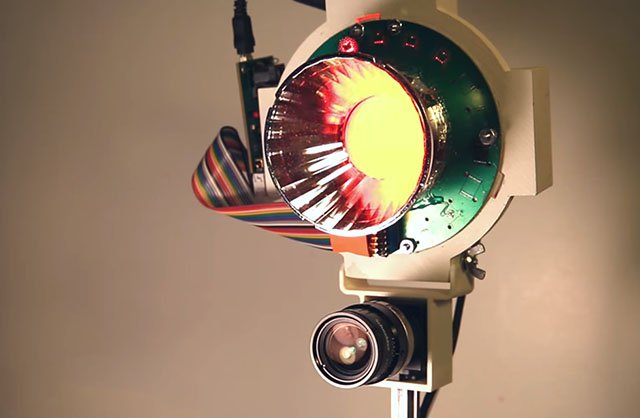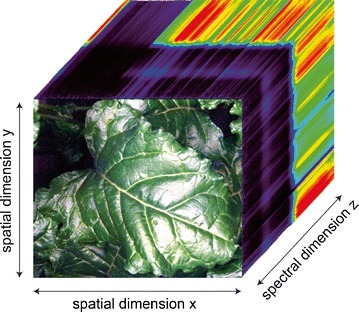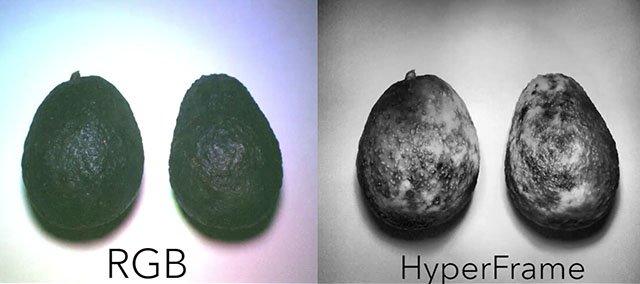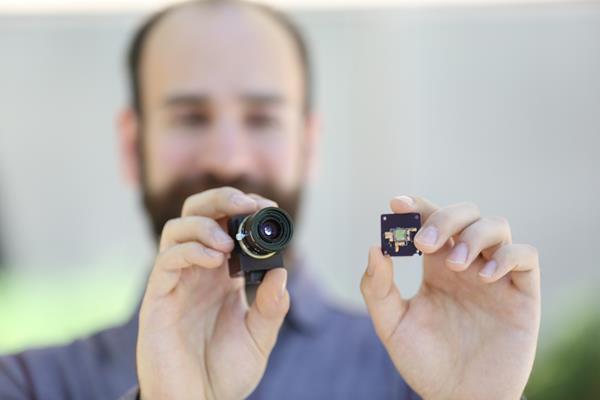
HyperCam, a camera employing hyperspectral imaging technology, processes images in ways that the human eye can’t. Courtesy of PetaPixel.
What is Hyperspectral Imaging?
Imagine an iPhone app that could help you choose the best produce, the ripest fruit, or determine if the vegetables you are about to buy are truly organic. Well, it turns out that this may not very far from reality thanks to advances in a branch of photonics called hyperspectral imaging.
Hyperspectral imaging falls into the general branch of spectroscopy called spectral imaging. Spectral imaging is the process in which a complete spectrum is collected at every location in an image. More specifically, hyperspectral imaging refers to the collection and processing of information across the entire electromagnetic spectrum. Because certain molecules and materials have unique identifiers in the electromagnetic spectrum, called a spectral signature, hyperspectral imaging is able to identify the different materials that make up the scanned object.
Sensors within the instrument collect a set of images, each representing a small range of wavelengths from the electromagnetic spectrum. Then, these images are combined to form a 3-dimensional image (x,y,z), where x and y are spatial dimensions and z is the spectral dimension composed of a range of wavelengths. This is also known as a “hyperspectral data cube.”

A hyperspectral image cube displays spacial and spectral dimensions at each pixel of an image. Courtesy of ResearchGate.
Whereas an ordinary camera acquires spectral information corresponding to the primary colors, red, green and blue, hyperspectral imaging divides the spectrum into many more bands. Furthermore, this type of imaging has the ability to acquire data far beyond the spectral range of the human eye. For example, the maximum wavelength visible to the human eye is about 700 nm, while certain hyperspectral imaging instruments are configured for up to 2500 nm. The wide range of wavelengths processed by these instruments offers the improved ability to characterize, identify, and quantify objects within an image.
Techniques Used
The two general branches of spectral imagers are push-broom scanners and snapshot imaging. Instruments utilizing push-broom scanners read images overtime, for example, like the moving scanner in a photocopier. Conversely, technologies employing snapshot imaging, such as those found in digital cameras and phones, generate images instantly.
There are several different scanning methods in which hyperspectral imaging sensors sample a hyperspectral cube. Snapshot imaging primarily acquires data through the non-scanning method. This means that it yields the full data of the cube all at once. This allows for a high light throughput and shorter data acquisition time.
However, push-broom scanners may employ three different methods for data acquisition. These include spatial, spectral and spatio-spectral scanning methods. Using spatial scanning technology, the image is processed line by line using the x and z dimensions of the cube. This differs from spectral scanning analysis which processes the cube by the x and y dimensions. Generally speaking, spatio-spectral scanning is considered to be a combination of the previous two methods.
In addition to scanning methods, different imaging modes are also available. Photoluminescence imaging systems rely on the light emission from matter after it absorbs photons. Similarly, electroluminescence imaging systems depend on the light emission from matter in response to a passing electric current. Raman imaging relies on the unique and specific vibrations of various molecules.
In general, hyperspectral cubes can be generated from airborne sensors, satellites, or handheld devices. Airborne sensors and satellites are typically used when land areas, such as farms or isolated terrains, need to be characterized. Devices developed for smaller imaging samples, such as hyperspectral cameras or microscopes, are beneficial for research and laboratory settings.
Applications of Hyperspectral Imaging
Recent advances in sensor development and computing power have allowed for hyperspectral imaging instruments to become a reality. Slow and unreliable prototypes have evolved into accurate processing equipment with many interesting applications.
Airborne hyperspectral imaging finds applications in agriculture for monitoring the health and development of crops. Hyperspectral technologies can detect the presence of chlorophyll, chemicals, and nutrients, which are crucial to most growth processes. One study done by Headwall Photonics successfully detected the early onset of citrus blight in orange groves through inspection of a byproduct produced by the disease on the surface of the leaves. Citrus blight causes thousands of trees to become unproductive each year and results in millions of dollars of losses. The ability to monitor crop health and minimize plant losses is an extremely valuable tool for agricultural and farming industries.

Hyperspectral imaging can determine the ripeness of fruit, past what the normal human eye can see. Courtesy of PetaPixel.
The medical industry utilizes hyperspectral technology for non-invasive disease diagnostics and surgical guidance. For applications such as wound analysis, it is assumed that as tissue changes with the course of a disease, so does its absorption, fluorescence and scattering characteristics. Thus, the types of light detected by hyperspectral imaging carries valuable quantitative diagnostic information.
Geologists use airborne applications to rapidly map commercial minerals and identify oil sources in the earth’s crust. As these areas are often remote and inaccessible, this technology helps geologists get a better idea of the terrain. Indicator minerals of potential ore deposits, such as opal and illite, are mapped and used to reduce the search area. Hyperspectral imaging paired with other remote sensing instruments and geographical information provides a highly descriptive visualization of the specified area.
Future of Hyperspectral Imaging
In 2015, a study was performed by PARC researchers to investigate a new approach to significantly reduce the cost of typical hyperspectral cameras. They predict that these miniature cameras will soon be available to the general public and found on handheld devices and mobile phones. In this case, users would have the ability to pick the ripest fruit at the grocery store, diagnose the condition of a wound, or even determine how much to water their gardens.

New studies aim to develop tiny hyperspectral cameras that the average consumer can afford. Courtesy of PARC.
Although hyperspectral imaging offers many advantages, the technology is still extremely costly. With prices ranging from $50,000 to over $1,000,000, implementation of hyperspectral instruments may still be unrealistic in some fields. However, with rapidly advancing technologies and computing power, hyperspectral imaging will likely expand in application, become more affordable, and continue to improve daily life.

Nice Blog…. This is really amazing. Great information about hyperspectral imaging.
Fantastic article…Thanks for sharing another great article. A lot of good info on Hyperspectral Imaging.
It was informative when you explained that hyperspectral imaging is used to identify materials that make up an object. I would imagine that it would be important to scan the materials that are being used in construction. It seems like it would be important to avoid using contaminated materials in construction.